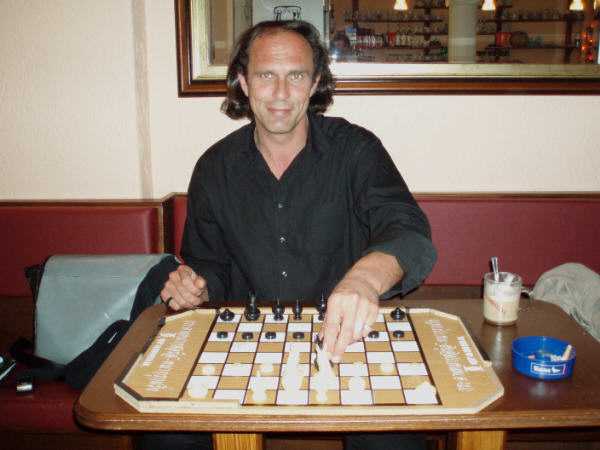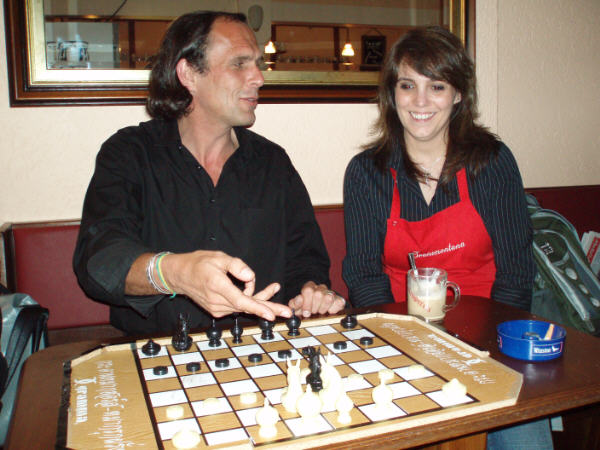THAI CHESS - THE "FOOLS MATE " IN MAKRUK THAI
SUDDEN DEATH UNDER THE HOT SUN OF SIAM
by Dr. René Gralla, Hamburg/Germany
"Cha, cha!" That is the slogan of the Thai people. "Keep calm, no hurry!" That is the way they try to lead their lives even if they have to fight for survival every day: have fun and relax as soon as there is a little bit of breathing-space left. The traditional Thai Chess is a mirror image of that down-to-earth attitude. The rhythm of Makruk Thai is laid back in comparison to the up-tempo beats of modern FIDE Chess. The main reason for that: There are neither omnipotent "Queens" nor long-range "Bishops" on the board.The King of Thai Chess is accompanied by a piece called "Met" - instead of being a "Queen". That "Met" is a 1:1-replica of the Vezir of Arabic Shatranj: The "Met" walks only one square diagonally per move (abbreviation in the following: "Q*"). The "Bishop" of Thai Chess has a limited radius too. That piece moves like the "Silver General" in Japanese Shogi, that is to say, either one square diagonally or one square straight forward per move (abbreviation in the following: "B*").
The foregoing leads to the assumption that surprise attacks in Makruk Thai are hardly imaginable. There are many similarities between Thai Chess and orthodox FIDE Chess, yet those common features do not seem to be sufficient to provide the players with the means necessary to bulldoze the opponent already in the early phase of a match. Let's have a look at the rules; so far we follow Hans Bodlaender at /oriental.dir/thai.html .
The opening set-up is very similar to modern international chess, apart from two modifications. White King and White "Queen" - that is to say: "Met", as we have already mentioned - have their positions reversed. That is different to modern chess and a 50-per cent-modification of the starting-out position of Classic Arabic Shatranj where Kings and Vezirs of both armies have their positions reversed with regard to FIDE Chess). Moreover the Pawns of Makruk Thai march into battle from advanced positions: row no. 3 (White) and row no. 6 (Black). Please see the diagram as follows.
DIAGRAM OF THE STARTING-OUT POSITION IN MAKRUK THAI
|
The King (abbr.: "K"), the Rooks (abbr.: "R") and the Knights (abbr.: "N") move the same way as their colleagues do in international chess. But there is one modification: Thai Chess does not approve of the castling option.
The Pawns (abbr.: "P") in Thai Chess march and strike just the same way as the infantrymen of orthodox FIDE Chess do. But the possibilities of promotion are frugal: The Pawns of Makruk Thai can solely rise to the status of "Met". One more special feature of Thai Chess: Since the Siam Fighters start out at row no. 3 (White) and row no. 6 (Black) - that is the peculiarity of Thai Chess -, so there is no need for the possibility of an initial two-step Pawn move; consequently that option does not exist in Thai Chess, and there is no room for the "en passant"-capture option. Besides from the foregoing Thai Chess speeds up the process of promoting Pawns: They can already rise to the rank of "Met" after having reached the 6th row (White) or 3rd row (Black); that distinguishes Thai Chess from orthodox FIDE Chess.
To sum it up: The slow-motion actions by the Thai Chess-"Queen" - that is to say: Met - and by Thai Chess-"Bishop" seem to exclude that it is possible to knock-out an adversary in just few moves, and a kind of "Fool's Mate" seems to be virtually unthinkable.
Right?! Wrong!!
The most astonishing truth is: A checkmate that White can inflict on
Black in 3 (!!) moves only is possible in Makruk too provided Black
plays fairly foolishly, of course.
The only difference to orthodox FIDE Chess: In the international variant
it is usually the Queen that executes that kind of very early knock-out
whereas in Thai Chess it is the Horse.
Let's first have a look at that basic blunder in orthodox FIDE Chess.
ORTHODOX FIDE CHESS: BLACK QUEEN KNOCKS AT WHITE BACKDOOR
White: Massoud Amini, GERBlack: Dr. René Gralla, GER
5-minutes blitz competition; November 2nd, 2004; Hamburg, Germany, Café & Bar "Roxy".
As reported on: www.chessbase.de/nachrichten.asp?newsid=4688 .
From's Gambit
1.f4 e5 2.f5(?!?) d5 3.g4???
Now Black Madam will suddenly show up at White back-door ...
3.
Qh4# 0-1 (diagram)
DIAGRAM OF FOOLS MATE IN ORTHODOX FIDE CHESS INFLICTED UPON WHITE
|
Black Madame has knocked at White back-door - and ... that's it! Because of the restrained rhythm of Southeast-Asian Chess that foregoing disaster should be impossible to be realized on the board of Makruk Thai.
But the Kingdom of Siam is full of surprizes.
THAI CHESS: THE BLITZ OF SIAM
 Mr. Torsten Mendel from Hamburg, Germany, who has explored the
strategies of Makruk Thai in a series of test matches with the author
Dr. René Gralla, demonstrates the Fools Mate-constellation that Black
can achieve against an unsuspecting White player in three moves.
Mr. Torsten Mendel from Hamburg, Germany, who has explored the
strategies of Makruk Thai in a series of test matches with the author
Dr. René Gralla, demonstrates the Fools Mate-constellation that Black
can achieve against an unsuspecting White player in three moves.
Photo:
Daniel Blank, Hamburg, Germany ©
Under the hot Sun of Siam you get dizzy sometimes.
Low Horse-Defence (Bogged-down Variant)
1.Nb1-d2 Nb8-d7 2.Nd2-e4 Ng8-e7?? (diagram)
White: Rook a1 // Thai-"Bishop" c1 // King d1 // Thai-"Queen" e1 // Thai-"Bishop" f1 // Knight g1 // Rook h1 ; Pawn a3 // b3 // c3 // d3 // e3 // f3 // g3 // h3 ; Knight e4; |
The configuration of two black Horses on Black lateral no. 7 is a good way to build a solid defence, but Black should have first played 1...d7-d6 (to prevent White Horse from moving to e4), then 2...Q*d8-c7 plus 3...Q*c7-d6 (a nice position for Blacks Met). Then he could have continued with the Low Horse maneuver 4...Nb8-d7 and 5...Ng8-e7.
3.Ne4xd6# 1-0 (diagram)
DIAGRAM OF THAI "FOOLS MATE" INFLICTED UPON BLACK
|
 Makruk-aficionado Mr. Torsten Mendel from Hamburg, Germany, explains
the Fools Mate in Thai Chess to nice Francisca who works in the
Portuguese café Transmontana in Hamburg, Germany, where Mr. Torsten
Mendel has staged a lot of test matches in Makruk Thai together with the
author Dr. René Gralla.
Makruk-aficionado Mr. Torsten Mendel from Hamburg, Germany, explains
the Fools Mate in Thai Chess to nice Francisca who works in the
Portuguese café Transmontana in Hamburg, Germany, where Mr. Torsten
Mendel has staged a lot of test matches in Makruk Thai together with the
author Dr. René Gralla.
Photo: Daniel Blank, Hamburg, Germany ©
A funny case of "Fool's Mate" in Thai Chess - by sudden Horse-strike. The most amazing fact: A disaster like that happens sometimes in real encounters too since novices of Thai Chess tend to overlook the deadly potential of the Horse that has galloped right into the centre of action. Master Tor Paknaam, who runs a Thai Chess-school at Samut Prakan at the Gulf of Thailand south of Bangkok, has won many matches in similar fashion against unsuspecting young talents.
STUDENT OF THAI CHESS GETS A FUNNY LESSON ...
White: Student of Thai ChessBlack: Master Tor Paknaam
Training match; Samut Prakan,Thailand, around 2005 and 2006, approximately.
The move-order has been demonstrated by Master Tor Paknaam to the author on the occasion of a visit at Tor Paknaams school for Thai Chess in Samut Prakan on October 2nd, 2007.
1.Nb1-d2 Ng8-e7 2.Ng1-e2
White should first have played 1.e3-e4, 2.Q*e1-f2, and 3.Q*f2-e3, before
erecting the Low Horse-constellation.
2...Ne7-f5! (diagram)
White: Rook a1 // Thai-"Bishop" c1 // King d1 // Thai-"Queen" e1 // Thai-"Bishop" f1 // Rook h1 ; Knight d2 // Knight e2; Pawn a3 // b3 // c3 // d3 // e3 // f3 // g3 // h3 ; |
Black Horse threatens to eat White Pawn e3.
3.e3-e4??
White wants to drive away Black Horse, but he should have defended Pe3 by 3.B*f1-f2 or 3.Q*e1-f2.
3...Nf5-e3# 0-1 (diagram)
DIAGRAM OF THAI "FOOLS MATE" INFLICTED UPON WHITE
|
So you better not fall asleep whilst sitting at the board of relaxed Makruk Thai. A cocky horse-laugh could wake you up ...
Written by Dr. René Gralla. Photo's by Daniel Blank. Webpage made by Hans Bodlaender
WWW page created: May 12, 2007. Last modified: May 17, 2007.